Sarah and I typically travel as a couple, but shortly before baby E was born, my mom suggested that they could accompany us on one of our trips. They could help with childcare, and we’d have an opportunity to create some family memories. The result was a family trip to Grand Cayman with the grandparents this November.
Choosing a destination
I wanted a nice, easy destination for this family trip. While I trust my wife to navigate the hurdles that occasionally arise during independent travel, I don’t have quite as much confidence in the folks. The last time we went abroad as a group it was to Mexico City. We hit a few snags including one that almost resulted in my dad missing the return flight. Beyond that, my wife (who speaks proficient Spanish) also got a bit tired of acting as the family translator. I have a vivid memory of my dad asking Sarah if he could bring his water into a museum. She responded, “I don’t know, Ken, I don’t work here.”
To be fair, I’m pretty certain that the only reason my dad ever leaves the country these days is to spend time with me. The two of us have successfully navigated Peru, Japan, Australia and New Zealand on past father-son trips. Still, in order to avoid as much stress as possible, I was looking for a developed, preferably English speaking country for this jaunt.
Utilizing the Southwest Companion Pass

If you follow this blog, then you know that my general goal is to maximize value while planning trips to new destinations. I can generally get Sarah and I just about anywhere for free (or close to it) using points and miles. My folks, however, have been slow to jump on the points and miles bandwagon. Luckily, my mom opened two Southwest credit cards this year, so both she and Sarah now have a ton of Rapid Reward Points and a Companion Pass. My dad and I are their designated companions. That means that the four of us can effectively get refundable two-for-one tickets to anywhere that Southwest flies.
If you would like to build up your own stockpile of Rapid Reward Points, consider signing up for one of Chase’s co-branded cards. If you use this link to complete your application then we’ll get some referral points, so everyone wins!
Settling on Grand Cayman
Southwest has a limited international route network. After four years of using our Companion Passes (combined with my pre-Sarah adventures), I’ve whittled down the number of “new” international destinations that we can reach on their planes. At this point, our options included Aruba, the Cayman Islands and Turks and Caicos.
Aruba isn’t that appealing, and we already visited neighboring Curacao this year, so we scratched that one off the list. Previous research had shown that the Turks and Cacaos can be a prohibitively expensive destination, even in the off season. I assumed Grand Cayman would also be a high dollar destination, but I was pleasantly surprised to see that it was substantially more economical than I expected in the off season. In November there are multiple two bedroom AirBnB options under $175 a night, and rental cars are dirt cheap. Economy cars are as little as $52 for a four night rental. We shelled out $115 for an SUV in order to get a bit more space. As a bonus, the island is a short flight from Florida and tickets were cheap (even before accounting for the Companion Pass.) We booked our flights, car and AirBnB for a four night/five day trip and then waited for November.
Destination Grand Cayman
Grand Cayman is the largest of three islands that make up the British Overseas Territory known as the Cayman Islands. Flat, swampy and lacking in arable land, the island was late to receive a permanent settlement, and for most of its history it existed as a backwater dependency administered from Jamaica. Turtle fishing and rope making drove the local economy. Mosquitoes were so numerous that cattle would suffocate when the blood suckers clogged their nostrils. It was not a place you’d want to visit. In fact, a lot of the population fled the island in search of economic opportunities abroad.
Things began to turn around for the territory in the middle of the 20thcentury. It broke away from Jamaica and elected to remain a British territory. The territory then took advantage of the globalizing economy to become an international tax haven. It built airports, infrastructure, and put a dint in the mosquito population. Now it is a major tourist destination with beachfront resorts, a large cruise port, and a skyrocketing real-estate market. In an ironic twist, an island once known for exporting labor now imports thousands of workers a year from as far away as Southeast Asia.
Our Experience on Grand Cayman’s Beaches
Our trip to Grand Cayman was short, by design. With just four nights on the ground and a trip plagued by rain, we couldn’t see everything. We did check off most of the to-do boxes east of the capital, though. Of course, beaches are the main draw card for the island. Here is a rundown of the beaches we hit, starting near Georgetown and moving counter-clockwise around the island.
Smith Cove
Smith Cove is a local favorite with plenty of shade trees, a photogenic coastline, toilet and shower facilities, and some BBQ areas. There was ample parking when we arrived mid-morning on Sunday. Several groups of Southeast Asian hospitality workers had set up around the BBQ areas, but there weren’t many tourists. That changed by about 11AM when cruise ship passengers in search of an “off the beaten path” beach began to arrive by taxi. We enjoyed some mediocre snorkeling, but then the sky darkened and the rain came. Little E had fallen asleep in Sarah’s lap. She didn’t want to abort the nap prematurely, so there she sat in the rain, holding a sleeping baby and getting soaked. That may have tainted the experience a bit in her mind.

Spott’s Beach
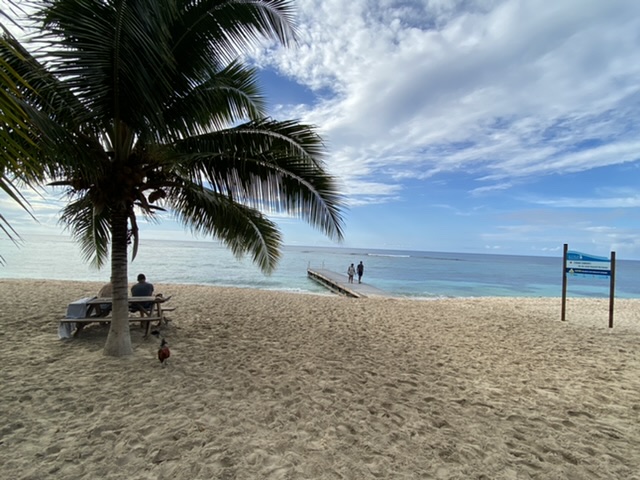
We took advantage of a brief sunny spell on Monday to visit Spott’s Beach. It has a nice stretch of sand that grows pink near the right-hand side of the beach. The beach offers a few covered benches, free parking and a port-a-john but no proper bathroom or shower facility. There is seagrass just off the coast, so its not the best place to swim. However, the seagrass does draw in sea turtles. You only had to swim out about fifty feet and look around to find them, and there were nearly as many turtles as at Playa Grandi in Curacao. The highlight for me was when mom and I saw a stingray swim over a turtle. Rock star.
The Blowholes
The blowholes may not be your typical Caribbean beach but they are located on the island’s most stunning stretch of coastline. As you head east along the southern coast, the elevation eventually begins to climb and you find yourself driving along a barren stretch of coastal cliffs that the locals refer to as the iron shore. A sign and small parking lot beside the road indicate the place where holes in the rock blast seawater into the sky. The phenomenon only happens during a rough sea though.
Mom and I happened across the blowholes on Sunday. It had been storming all afternoon. We were starting to get cabin fever so we left Sarah, E and my dad at the apartment and went for a drive. It turns out that the very weather that had wrecked our afternoon had amplified the blowholes. Standing there on the iron shore in the cold rain, watching the water blow nearly ten feet into the sky, I began to feel that we were suddenly in a different, more interesting place.
Colliers Beach
We stopped by Colliers Beach during the final evening of our trip. I read that Colliers, which is located on the eastern corner of the island, is a decent snorkeling spot but it is extremely shallow with a lot of sea grass. Not the sort of place I’d want to swim. There is a long pier though, which lets you walk out a good ways above the water. I saw some interesting fish and a small shark while standing on the pier, and it served as a great setting for family photos.
The plan was to only spend about 45 minutes on the beach, but it was totally vacant, and for once the weather was perfect. We changed plans and extended our stay. I took turns walking along the shore with both parents while Sarah read and E played in the sand. As sunset closed in, the seabirds began to fish in the water just off shore, providing great entertainment. As I look back, the time on Colliers Beach was probably the highlight of the trip.
Rum Point
Rum Point is not so much a beach as a private seaside bar with loads of sun chairs and a few hammocks. On the day that we visited, 18K cruisers had arrived in port, so we started early to beat the crowd. We arrived about 45 minutes before the bar even opened at 10AM. That was for the best. With no music or crowds Sarah was able to fit in a decent nap for E beside the sea.
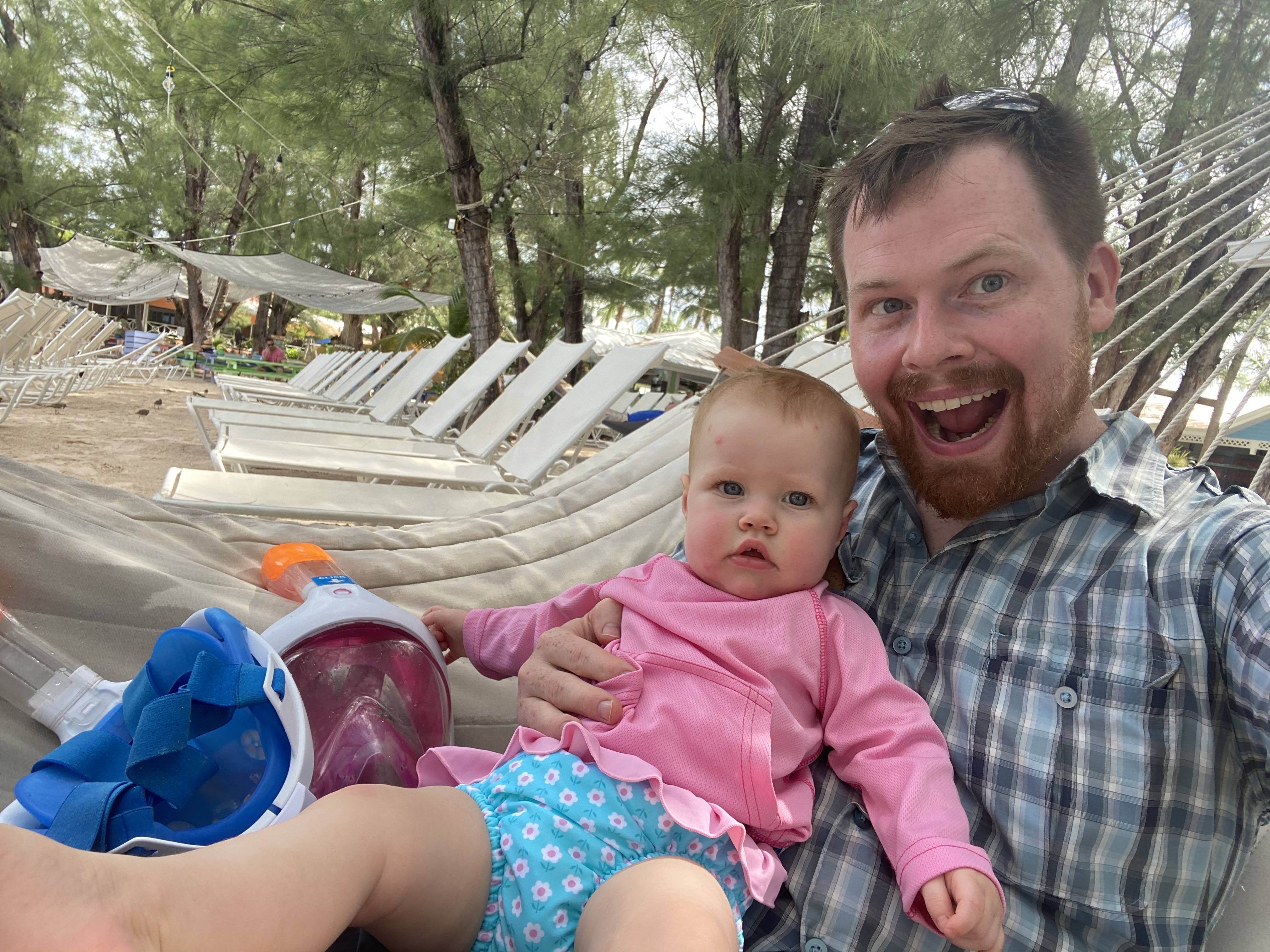
While nothing to rave about, the food and drink prices weren’t too bad, and the staff wasn’t pushy. I get the impression that you could post up on chair for half the day without ordering anything and no one would run you off. There is a shallow, sandy beach which is nice for kids and a dive/tour shop on the premises. To the right of the beach is a snorkeling area with soft coral but the coastline is also extremely silty. As a result, the visibility was horrid on the day that we visited.
Water Cay
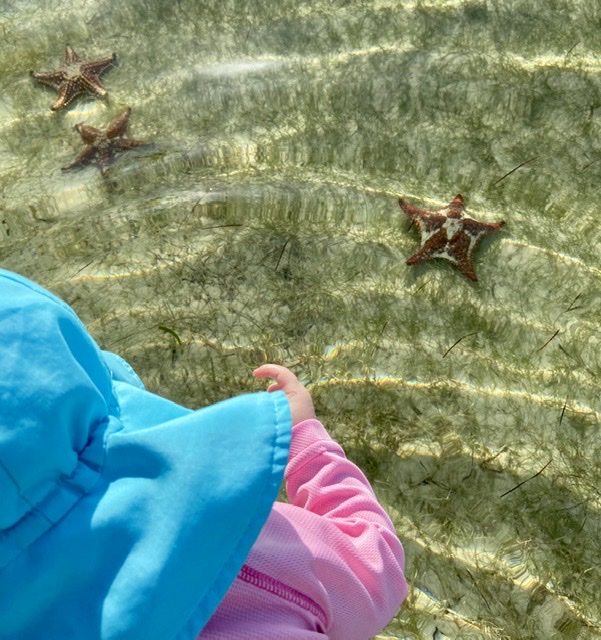
Also known as Starfish Point, Water Cay is a stretch of undeveloped beach located on a long finger of land to the southwest of Rum Point. To get there, just take a left at Rum Point and keep on driving past a couple miles of over-sized beach houses. There is a shaded parking lot at the end of the road, and the beach stretches off to the right. The main reason to come here is to check out the starfish that sit in the sand just off the coast. We got there early, but I understand that it can get busy during the day. A lot of boats making a quick stop as part of the “stingray city” tour. Stingrays also congregate in the area, and we were able to see some while snorkeling. Otherwise, I can’t see much of a reason to snorkel here.
Observations and Advice for Visiting Grand Cayman
If you’re a likeminded individual and have an interest in visiting Grand Cayman, keep the following things in mind.
Watch out for Chickens!

I’ve been on islands with a lot of chickens before, but Grand Cayman takes it to a whole new level. Chickens are everywhere. In fact, there are chickens right outside of the airport, milling around the rental car lot. Instead of hauling all our belongings into the rental car office, I went in alone to sort out the paperwork while the rest of the family waited next to the building. Baby E was acting a little fussy so Sarah gave her a few crackers to munch on. Then it happened – a darn chicken, drawn to the crackers, hopped up on the stroller and attacked E’s hand. She was fine but a word of caution: don’t give your baby crackers in the presence of chickens. They won’t show proper restraint.
If you want to avoid the crowds, look east.
Most of the population and tourism development is concentrated on the western portion of the island, around the capital and a long stretch of sand known as Seven Mile Beach. Being averse to the cruise and resort crowd, we opted to stay in the east. We skipped Seven Mile Beach during our trip. In doing so, we were able to avoid the crowds, visit some unhurried beaches, and take in some star attractions like the Queen Elizabeth Botanic Park.
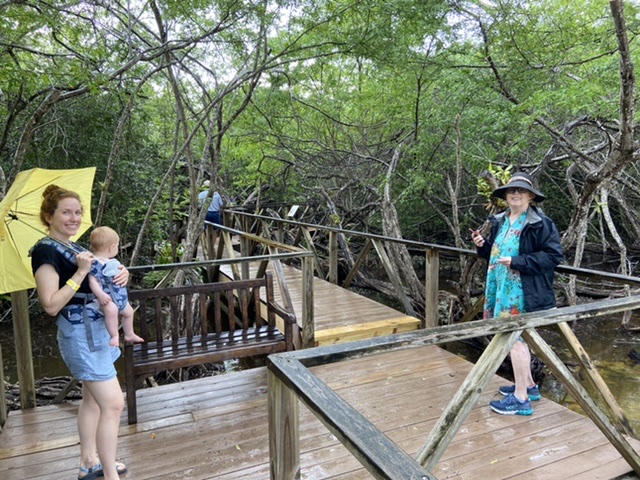
We stayed near Bodden Town because of its relatively central location, but the area is basically one main road along the coast with low lying swamp as far as the eye can see to the north. Were we to return, I would probably aim for the area around East End. It has a higher elevation with some minor sea cliffs and is close to some decent beaches and nice hole-in-the-wall eateries. If you are looking for something that offers a more posh vacation home vibe without the resort feel of Seven Mile, the North Side near Rum Point may be worth a look.
Don’t come looking for history…
Grand Cayman was a poor backwater for most of its history, so it doesn’t have much to offer the history/culture crowd. Perhaps the best known historical attraction on the island is Pedro St. James Castle which was constructed around 1780 and is the oldest stone building on the island. The house is nicknamed the “Birthplace of Democracy in the Cayman Islands” because it was here that the local elites first met to form a parliamentary government in 1831. It was also from here that the abolition of slavery was formally announced in 1835. By 1920, though, the house had been abandoned and fell into ruin.

Then things get interesting. In 1959, an eccentric American named Thomas Hubbell purchased the property. He then altered the stone ruin to make it resemble a castle. He began promoting it as the former fortress of a fictitious pirate named Pedro St. James. After Hubbell moved out, other owners ran the property, off and on, as a restaurant and hotel until a hurricane and fire in the late 1980’s gutted the property. The government purchased the ruins in 1991 and began the process of bringing it back to its 19thcentury glory. Much had been lost to neglect or warped by the creative Mr. Hubbell, so the conservationists relied on old photographs and sketches of the building, as well as clues left in the stone structure. Where all else failed, they looked to great houses in Jamaica for inspiration.
The end result is a beautiful and unique great house, set on manicured grounds and run as one of the island’s premiere tourist attractions. The greatest irony of all, though, is that one of the island’s most historic structures is largely a twenty year-old reproduction that derives its name from the fantasies of a mid-twentieth century American eccentric. It is totally worth a visit.
Groceries will cost you
If you follow this blog then you know that one of my cost saving mantras is to rent a place with a kitchen and self-cater as much as possible. This typically leads to some real savings, but those savings are harder to come by on Grand Cayman.
The grocery and liquor stores are closed on Sundays, so our first priority was provisions when we arrived Saturday afternoon. At the store, Mom, Sarah and I split up and put groceries into two carts. We tried to be frugal. When it came time to pay, we began unloading the cart at one cash register before pivoting to an empty one when the clerk at our first seemed to encounter a technical issue. We were a bit taken off guard when the total came to $180 for groceries alone. At our local Aldi this haul would have come in at about $75, but islands are usually more expensive. At least we had now paid for most of our meals during the trip.
When we got home, my dad and I walked over to the little beach across the street from our apartment for a sun-downer while Sarah started to work on dinner. It wasn’t long before she came out to report that neither the chicken we’d gotten for dinner nor the blueberries we’d gotten for E were in the kitchen. We checked the grocery receipt and somehow they’d never made it to the till. We would later learn that, among other things, the yogurt we’d gotten for breakfast, the potatoes for Sunday’s dinner, and the pasta for Monday hadn’t made it from the cart to the register, either. So much for $180 worth of groceries being sufficient for most of our meals.
In the end, I wish we had devoted a few more meals to the hole-in-the-wall restaurants that dot the coast. Of the few that we did visit, I would love to return to Captain Herman’s. It delivered a great feast of conk stew, conk fritters, and fried barracuda. The stew itself could be a stand-alone meal and only cost $6.25. The barracuda (E’s first) tasted amazing, and a portion large enough for two came in at $17.50.
As an aside, there is something odd going on with the real estate…
I have never seen a real-estate market like the one on Grand Cayman. Magazines flog luxury condos priced in the millions. At times it felt like you couldn’t spit without hitting a for-sale sign. The construction industry is just about as busy there as in my hometown of Nashville, and yet we also saw a lot of seemingly abandoned projects.
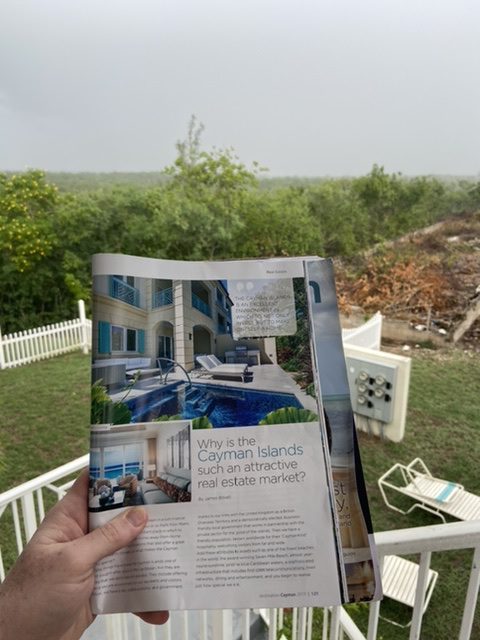
The official line is that the island provides a stable, business-friendly environment to park your money. The real-estate values can only go up. Yes, the island has nice beaches, is well connected, and is so “pro-business” that it claims more registered companies than inhabitants. It is also flat and surrounded by the sea. In fact, several of the projects we saw required infilling swampland to get above the water level. At a time when climate change is resulting in rising seas and supercharged hurricanes, calling this place a good investment is insane. The fact that people seem to be buying in speaks to the fact that you don’t have to be smart to have a lot of money.
In Conclusion
I’d figured out a full roster of potential activities for every day of our trip. Unfortunately it ended up raining a lot during our brief stay on Grand Cayman. That, combined with the baby’s nap schedule meant that we spent more time than I would have liked in the apartment. It was frustrating.
Still, I think we all came away with some pleasant memories. For me, those include standing in the rain and admiring the blowholes with my mom, taking the apartment’s sea kayaks out for a spin with my dad, snorkeling with sea turtles and stingrays, chowing down on some excellent barracuda at Captain Herman’s, enjoying the sunset with the entire family on Colliers beach, and getting out for a little dinner date with Sarah on the last night while the folks watched E.
Grand Cayman may not be the world’s most fascinating destination, but it sure is convenient. I assume that convenience is what keeps people coming back. While it certainly isn’t high on my list of repeat destinations, the eastern half of the island did provide a nice, low-key place to spend some time with the family. If you’re looking for an easy international family beach vacation that doesn’t break the bank, this may be worth considering.
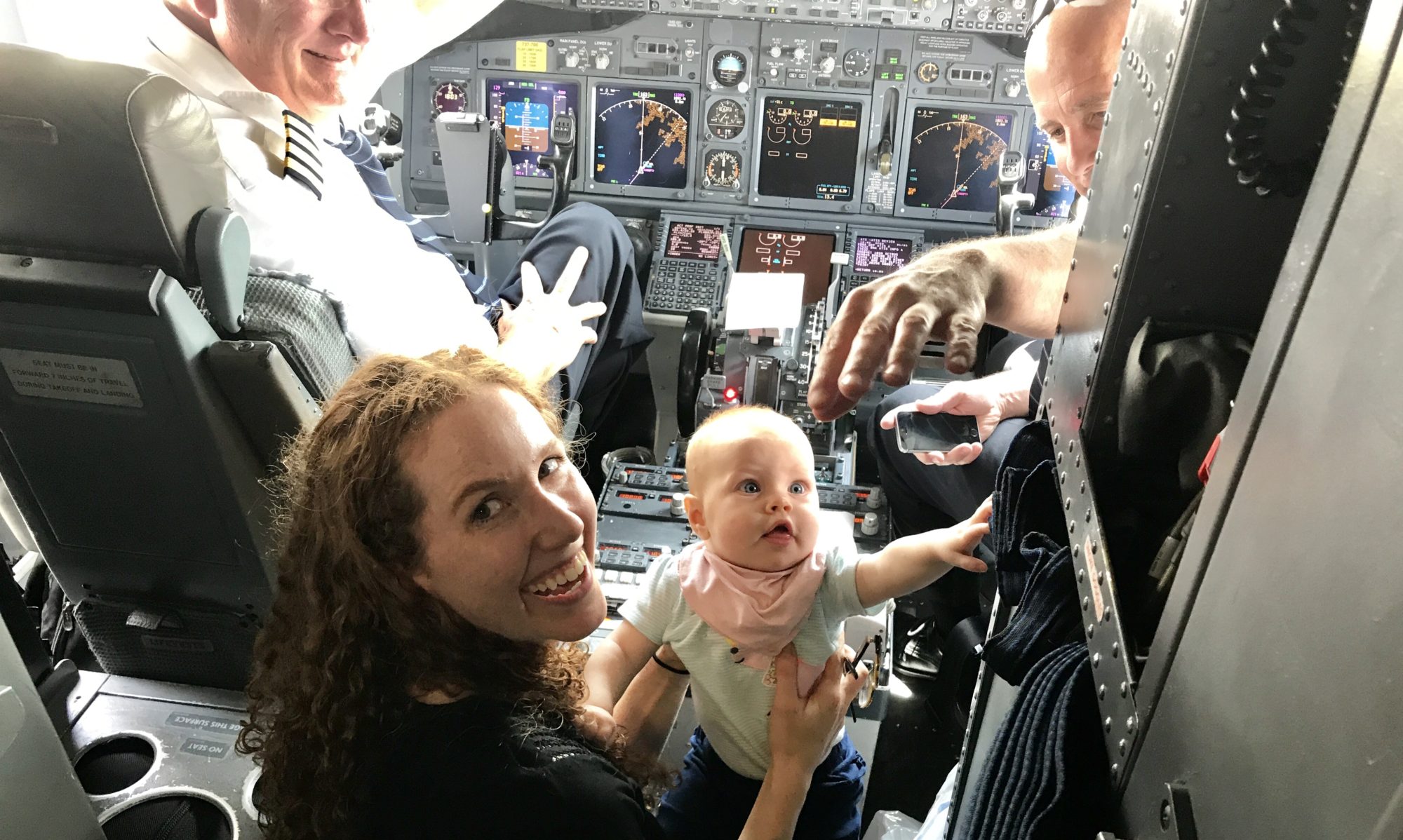
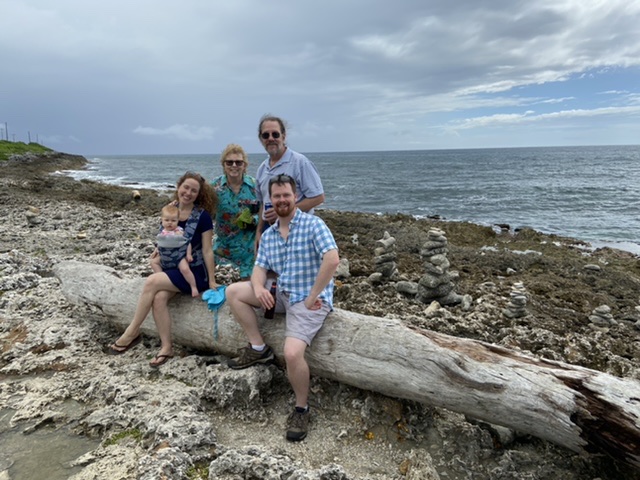
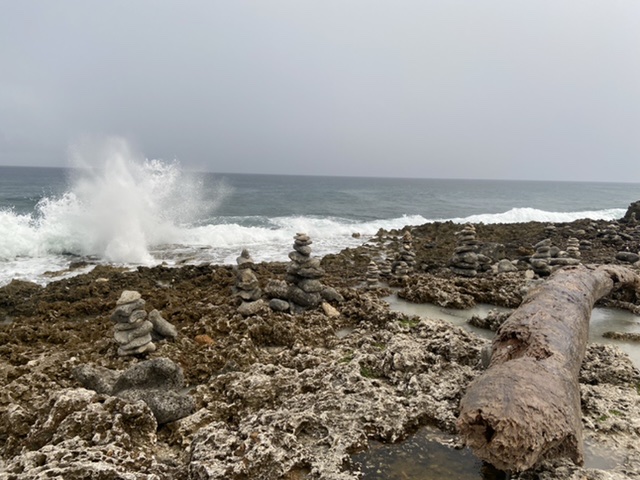

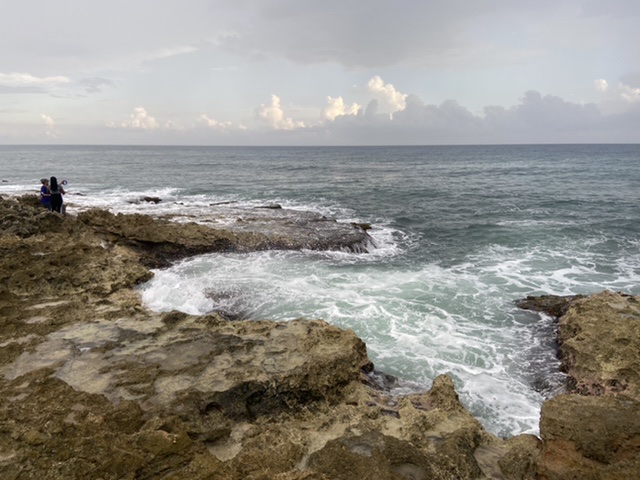
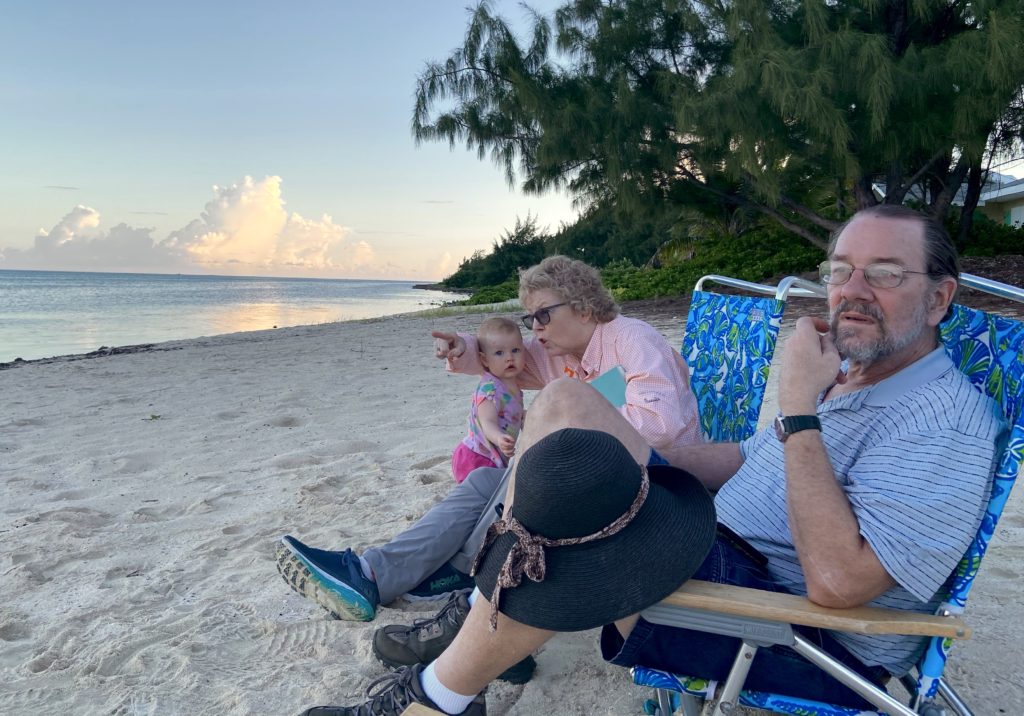
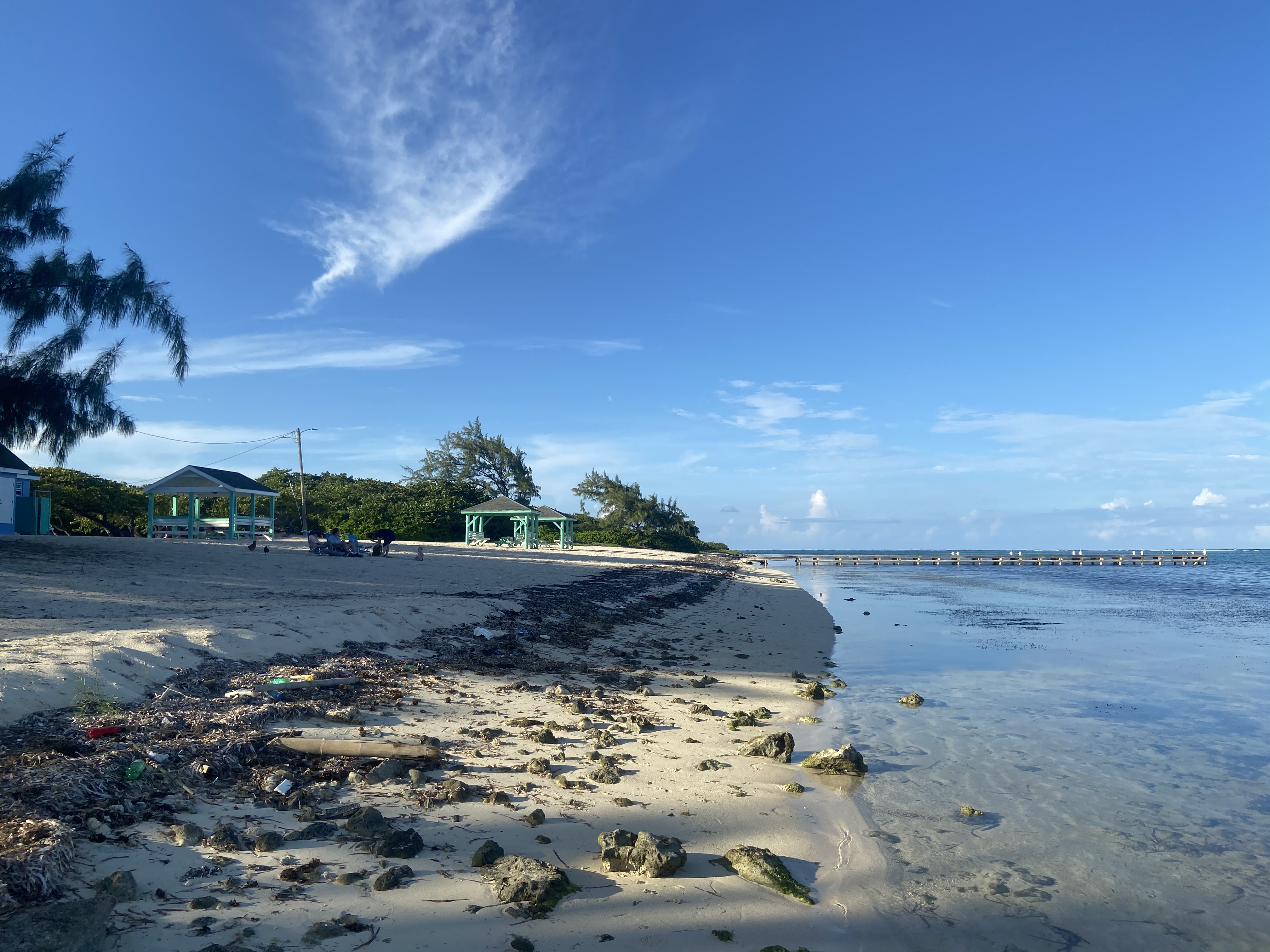




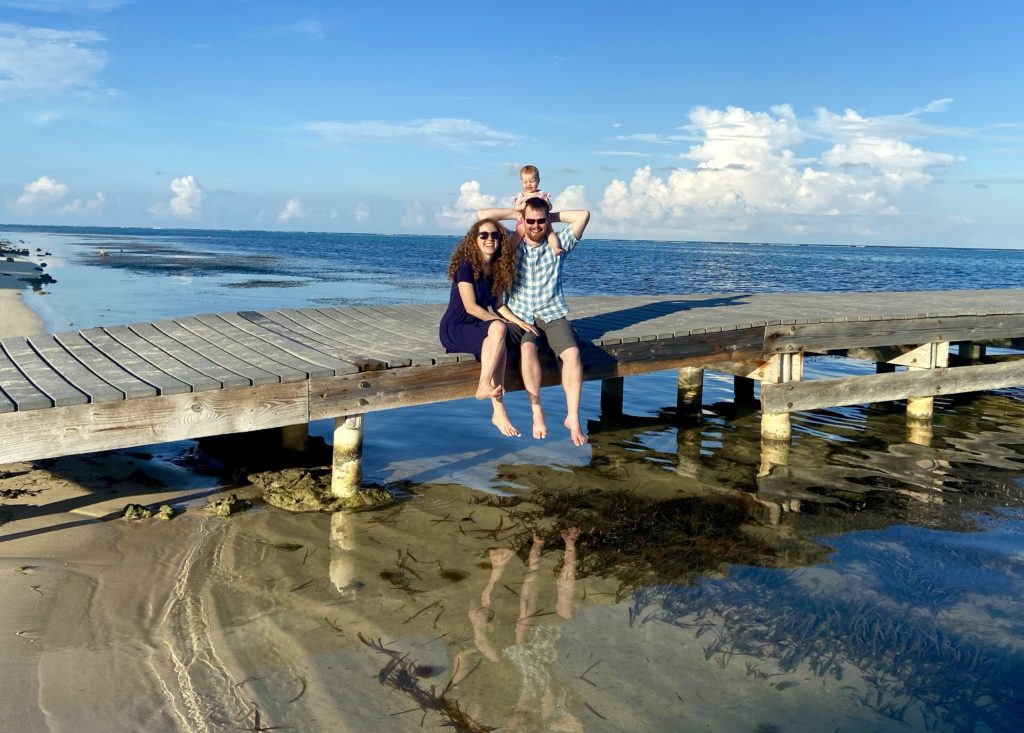


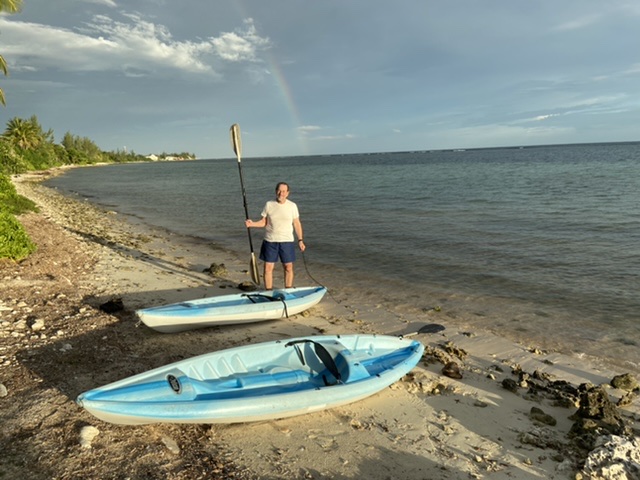
Fun trip and fun read.